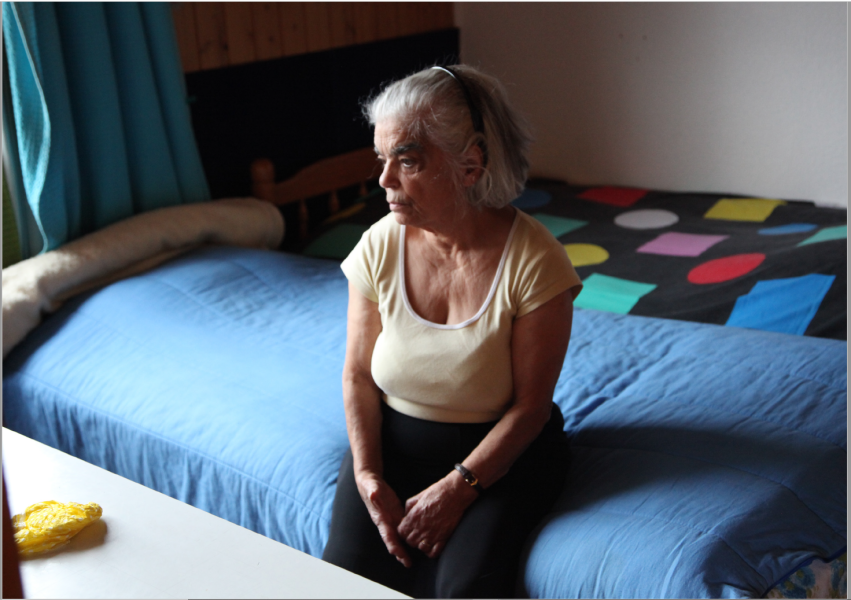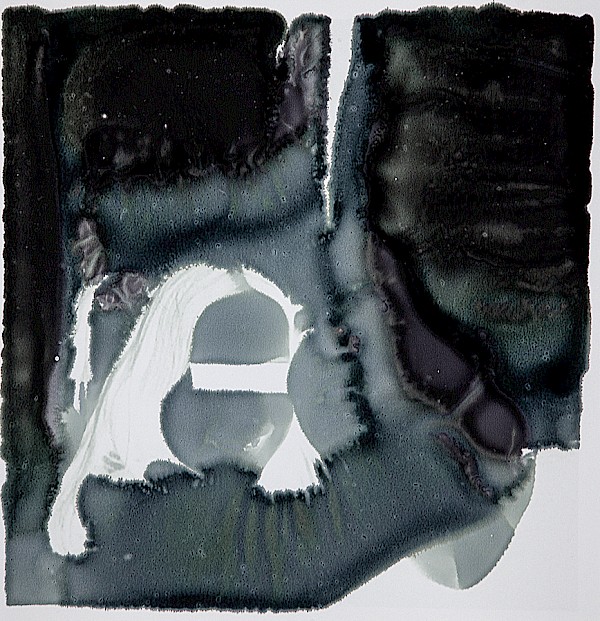
Leaf-lets
Description
Temporary exhibition "Concerned : 30 artists on humanitarian issues"
Hello I'm ciel grommen, i'm an artist based in belgium, and five years ago i did a master in contemporary art at the HEAD here in geneva. It was a a master where I could reposition myself towards architecture the field in which I'm originally trained. I developped here a research methodology that I am still using today. It's a reserch methodology that i call, research by habitation.
Most projects start from a place that is symbolic in a certain way. That is symbolic for certain topics that interest me and of a global influence, then habitation has to be understood in a large sense. I spend a lot of time there, i give myself a role, and set up relations with other habitant of its space. I observe, I experience I try things out. What inspires me is how this very situated experience relates to the general debate about a place.
For some years the focus of my work were extraterritorial places. Spaces of exception, where another law and a national law applies. Such as border zones, refugee camps, free ports. The project I present here is one on the border zone between north and south korea. It is called the demilitarized zone, the DMZ pointing on the factbthat it was created during an armistice, its therefore a border that simbolises a war that did not end. What stroke me was the beauty of the landscape, the silence and the nature. The isolation, along the 250 kilometer length of the DMZ has namely created an involuntarely nature reserve. inhabited by several endangered animal and plant species.
I was of course not the only one that remarjked this. Even the soldiers pointed on the beautiful birds they spotted though their binoculars. And therefore its also not so surprising that this unique wildlife refuge is gaining interest from all over the world. After two weeks of excursion in this strange area i returned to geneva. the city of the united nations. Since my way of working very much involves debate and physical presence i decide to focus on this international debate. And i found out that the IUCN, or the interntinal union for conservation of nature was since some time spreading the idea to cnserve this border zone, by turning it into a peace park.
A peace park and nature reserve? Run by two bordering and hostile states. The IUCN has organised different international seminars about this idea. exhibitions and others. And insulation really starts from these documents. It is a selection of papers that shaped this debate. But with a laser cutter i cut out plans that are critically endangered and situated in this zone. As a kind of help barrier, this action destroys the documents in a way but at the same time it makes them alive. Next to the leaflet you find a map painted on the wall.
It is the Baekgdudaegan mountain range. that is the backbone of the korean peninsula. Do you know that in the korean language there is not one word that exists for Korea? The Baekgdudaegan is a very imoportant symbol for the identity of this island. and sicne in Asia, mountains are considered sacred, it is also in most parts very well conserved. Therefore, i question if this mountain is maybe not the actual peace park we have to look at.
As an architect i am fascinated by maps. But at the same time I understand that a map is not at all innocent. especially here. a single map on a paper has had huge consequences for the life of many human and non human actors. I wanted to make a map without borders, without closed lines. Therefore I found a painting from a palace of the dongwoldu dinasty, it is a kingdom dating back from the time when the korean people were still united. And it was located in these mountains. From this painting I took a detail of this mountains and i turned it into this drawing. And this way i can presnet now a map, that exist now only of parallel lines. and shows a territory of assembly, a territory of identity that is not closed off, and that is opening.
This work was presented as part of the exhibition CONCERNED: 30 ARTISTS ON HUMANITARIAN ISSUES, from 27 April to 26 September 2021.
Credits
Ciel Grommen, 2014. © Courtesy of CICR & Ville de Genève. International Red Cross and Red Crescent Museum, Geneva.
Tags
ImagesExhibitionsLinked contents
Concerned | the view of Isabel Rochat
Videos, Focus

Mes voisins - Francesca dans ses pensées
Images, Exhibitions

Estelle Veneut – Badr Smati
Images, Exhibitions

1213 Onex or The Manifest of a Third Culture
Images, Exhibitions

The Pussy Talk
Images, Exhibitions

TOC, TOC, Territoire Occupé Convenablement
Images, Exhibitions


Leaf-lets
Description
Temporary exhibition "Concerned : 30 artists on humanitarian issues"
Hello I'm ciel grommen, i'm an artist based in belgium, and five years ago i did a master in contemporary art at the HEAD here in geneva. It was a a master where I could reposition myself towards architecture the field in which I'm originally trained. I developped here a research methodology that I am still using today. It's a reserch methodology that i call, research by habitation.
Most projects start from a place that is symbolic in a certain way. That is symbolic for certain topics that interest me and of a global influence, then habitation has to be understood in a large sense. I spend a lot of time there, i give myself a role, and set up relations with other habitant of its space. I observe, I experience I try things out. What inspires me is how this very situated experience relates to the general debate about a place.
For some years the focus of my work were extraterritorial places. Spaces of exception, where another law and a national law applies. Such as border zones, refugee camps, free ports. The project I present here is one on the border zone between north and south korea. It is called the demilitarized zone, the DMZ pointing on the factbthat it was created during an armistice, its therefore a border that simbolises a war that did not end. What stroke me was the beauty of the landscape, the silence and the nature. The isolation, along the 250 kilometer length of the DMZ has namely created an involuntarely nature reserve. inhabited by several endangered animal and plant species.
I was of course not the only one that remarjked this. Even the soldiers pointed on the beautiful birds they spotted though their binoculars. And therefore its also not so surprising that this unique wildlife refuge is gaining interest from all over the world. After two weeks of excursion in this strange area i returned to geneva. the city of the united nations. Since my way of working very much involves debate and physical presence i decide to focus on this international debate. And i found out that the IUCN, or the interntinal union for conservation of nature was since some time spreading the idea to cnserve this border zone, by turning it into a peace park.
A peace park and nature reserve? Run by two bordering and hostile states. The IUCN has organised different international seminars about this idea. exhibitions and others. And insulation really starts from these documents. It is a selection of papers that shaped this debate. But with a laser cutter i cut out plans that are critically endangered and situated in this zone. As a kind of help barrier, this action destroys the documents in a way but at the same time it makes them alive. Next to the leaflet you find a map painted on the wall.
It is the Baekgdudaegan mountain range. that is the backbone of the korean peninsula. Do you know that in the korean language there is not one word that exists for Korea? The Baekgdudaegan is a very imoportant symbol for the identity of this island. and sicne in Asia, mountains are considered sacred, it is also in most parts very well conserved. Therefore, i question if this mountain is maybe not the actual peace park we have to look at.
As an architect i am fascinated by maps. But at the same time I understand that a map is not at all innocent. especially here. a single map on a paper has had huge consequences for the life of many human and non human actors. I wanted to make a map without borders, without closed lines. Therefore I found a painting from a palace of the dongwoldu dinasty, it is a kingdom dating back from the time when the korean people were still united. And it was located in these mountains. From this painting I took a detail of this mountains and i turned it into this drawing. And this way i can presnet now a map, that exist now only of parallel lines. and shows a territory of assembly, a territory of identity that is not closed off, and that is opening.
This work was presented as part of the exhibition CONCERNED: 30 ARTISTS ON HUMANITARIAN ISSUES, from 27 April to 26 September 2021.
Credits
Ciel Grommen, 2014. © Courtesy of CICR & Ville de Genève. International Red Cross and Red Crescent Museum, Geneva.
Tags
ImagesExhibitionsLinked contents
Concerned | the view of Isabel Rochat
Videos, Focus

Mes voisins - Francesca dans ses pensées
Images, Exhibitions

Estelle Veneut – Badr Smati
Images, Exhibitions

1213 Onex or The Manifest of a Third Culture
Images, Exhibitions

The Pussy Talk
Images, Exhibitions

TOC, TOC, Territoire Occupé Convenablement
Images, Exhibitions

Nothing to discover